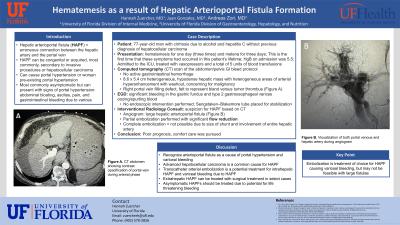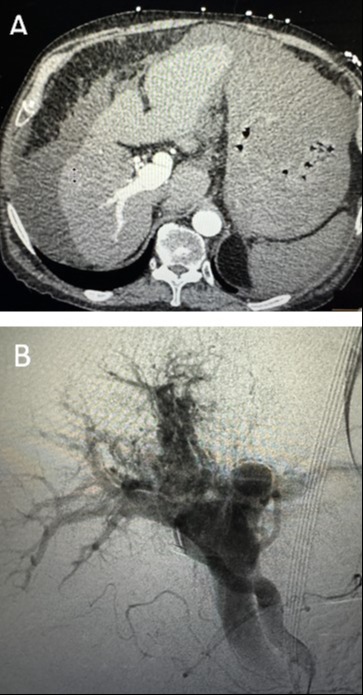Sunday Poster Session
Category: GI Bleeding
P0768 - Hematemesis as a Result of Hepatic Arterioportal Fistula Formation
Sunday, October 27, 2024
3:30 PM - 7:00 PM ET
Location: Exhibit Hall E

Has Audio

Hannah L. Zuercher, MD
University of Florida College of Medicine
Gainesville, FL
Presenting Author(s)
Hannah L. Zuercher, MD, Juan Gonzalez, MD, Andreas Zori, MD
University of Florida College of Medicine, Gainesville, FL
Introduction: Hepatic arterioportal fistula (HAPF) is an erroneous connection between the hepatic artery and the portal vein, likely stemming from high portal vein blood flow. HAPF can be congenitally acquired or, more commonly, secondary to procedural interventions, such as liver biopsy. HAPF can lead to the development of portal hypertension or worsen pre-existing portal hypertension. Yet, most patients tend to remain asymptomatic. Nonspecific symptoms of HAPF can include abdominal bloating, pain, and gastrointestinal bleeding. The standard of care when it comes to HAPF presenting with gastrointestinal bleeding is embolization.
Case Description/Methods: A 77-year-old man with a history of cirrhosis due to alcohol and hepatitis C presented with hematemesis and melena, requiring vasopressors and blood transfusions. Computed tomography (CT) scan of the abdomen/pelvis described no active gastrointestinal hemorrhage, an 8.6 cm heterogeneous hepatic mass concerning for malignancy, and a right portal vein filling defect, felt to represent bland versus tumor thrombus (Figure 1, part A). Esophagogastroduodenoscopy demonstrated significant bleeding in the gastric fundus and type 2 gastroesophageal varices oozing/spurting blood, no endoscopic intervention was performed. Sengstaken–Blakemore tube was placed for stabilization. Upon further imaging review with interventional radiology, suspicion was raised for an arterioportal fistula. Angiogram demonstrated a large hepatic arterioportal fistula (Figure 1, part B). Partial embolization was performed with significant flow reduction. However, complete embolization was not possible due to the size of the shunt and involvement of the entire hepatic artery due to supply from right/middle/left hepatic artery branches. Given the patient’s poor prognosis, comfort care was chosen.
Discussion: This case highlights the importance of considering arterioportal fistula formation as a cause of portal hypertension leading to variceal bleeding in patients with hepatocellular carcinoma. Although transcatheter arterial embolization is a potential treatment for arterioportal fistula, it may not be feasible to embolize all involved areas.

Disclosures:
Hannah L. Zuercher, MD, Juan Gonzalez, MD, Andreas Zori, MD. P0768 - Hematemesis as a Result of Hepatic Arterioportal Fistula Formation, ACG 2024 Annual Scientific Meeting Abstracts. Philadelphia, PA: American College of Gastroenterology.
University of Florida College of Medicine, Gainesville, FL
Introduction: Hepatic arterioportal fistula (HAPF) is an erroneous connection between the hepatic artery and the portal vein, likely stemming from high portal vein blood flow. HAPF can be congenitally acquired or, more commonly, secondary to procedural interventions, such as liver biopsy. HAPF can lead to the development of portal hypertension or worsen pre-existing portal hypertension. Yet, most patients tend to remain asymptomatic. Nonspecific symptoms of HAPF can include abdominal bloating, pain, and gastrointestinal bleeding. The standard of care when it comes to HAPF presenting with gastrointestinal bleeding is embolization.
Case Description/Methods: A 77-year-old man with a history of cirrhosis due to alcohol and hepatitis C presented with hematemesis and melena, requiring vasopressors and blood transfusions. Computed tomography (CT) scan of the abdomen/pelvis described no active gastrointestinal hemorrhage, an 8.6 cm heterogeneous hepatic mass concerning for malignancy, and a right portal vein filling defect, felt to represent bland versus tumor thrombus (Figure 1, part A). Esophagogastroduodenoscopy demonstrated significant bleeding in the gastric fundus and type 2 gastroesophageal varices oozing/spurting blood, no endoscopic intervention was performed. Sengstaken–Blakemore tube was placed for stabilization. Upon further imaging review with interventional radiology, suspicion was raised for an arterioportal fistula. Angiogram demonstrated a large hepatic arterioportal fistula (Figure 1, part B). Partial embolization was performed with significant flow reduction. However, complete embolization was not possible due to the size of the shunt and involvement of the entire hepatic artery due to supply from right/middle/left hepatic artery branches. Given the patient’s poor prognosis, comfort care was chosen.
Discussion: This case highlights the importance of considering arterioportal fistula formation as a cause of portal hypertension leading to variceal bleeding in patients with hepatocellular carcinoma. Although transcatheter arterial embolization is a potential treatment for arterioportal fistula, it may not be feasible to embolize all involved areas.

Figure: Figure 1. Visualization of the hepatic arterioportal fistula on computed tomography (CT) scan (Part A) and transcatheter arterial angiography (Part B).
Disclosures:
Hannah Zuercher indicated no relevant financial relationships.
Juan Gonzalez indicated no relevant financial relationships.
Andreas Zori indicated no relevant financial relationships.
Hannah L. Zuercher, MD, Juan Gonzalez, MD, Andreas Zori, MD. P0768 - Hematemesis as a Result of Hepatic Arterioportal Fistula Formation, ACG 2024 Annual Scientific Meeting Abstracts. Philadelphia, PA: American College of Gastroenterology.
